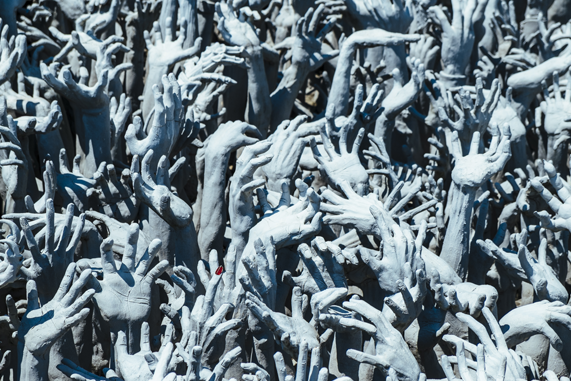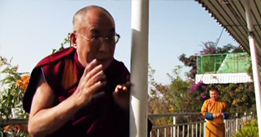
For Buddhists, the universe has no beginning. Various world systems come into existence and eventually cease to be, but other worlds precede and follow them. The Buddha is said to have discouraged speculation about the origin of the universe; the question of whether the world has a beginning is one of fourteen questions that the Buddha refused to answer. He also remained silent when asked whether the universe will ever come to an end. Individual worlds are destroyed, incinerated by the fire of seven suns; but, no apocalypse, no final end time, is foretold. Individual beings put an end to their individual existence, one that also has no beginning, by traversing the path to nirvana.
This does not mean that Buddhists do not have creation myths. One is offered in the Agganna Sutta, which describes how beings first came to populate a newly formed world system and how gender, sexuality, private property, labor, and government came into existence. The place that they inhabit—and which we inhabit, according to the Buddhists—is an island continent called Jambudvipa, “Rose Apple Island,” in a great sea. It is the southern continent, one of four continents in a flat world, situated in the four cardinal directions around a central mountain called Mount Meru. The mountain is in the shape of a great cube, each of its four faces composed of a different kind of precious stone. The southern face of the mountain is made of lapis lazuli and so when the light of the sun reflects off Meru’s south face, it turns the color of our sky blue. Gods live on the slopes of the mountain and on the summit. It was in the heaven on the summit on Mount Meru that the Buddha taught the Abhidharma to his mother.
The Buddha, like other teachers of his day, believed in rebirth—a process of birth and death called samsara, literally “wandering.” According to the Buddha, this process has no beginning and will not end unless one brings it to an end. Until then, each being is born in lifetime after lifetime into one of six, and only six, realms: as a god, demigod, human, animal, ghost, or denizen of hell. This is not a process of evolution but rather very much an aimless wandering from realm to realm, up and down, for aeons, a process that on the surface appears entirely random. The gods live above our world, some on the surface of the central mountain, some in the heavens above it. Their lives there are long but not eternal. For the gods who live on the summit of Mount Meru, the life span is a thousand years, and every day of those years is equal in length to one hundred human years. In the heavens arrayed above the summit of Mount Meru, the life spans are longer. These heavens as well as the realms of demigods, humans, animals, ghosts, and the denizens of hell, together constitute what is called the realm of desire, because the beings there desire the pleasures that derive from the five senses, constantly seeking beautiful things to see, hear, smell, taste, and touch. Above the desire realm are the heavens of the realm of form, where the gods have bodies made of a subtle matter invisible to humans; having no need for food or drink, these gods only have the senses of sight, hearing, and touch. The highest Buddhist heavens are located in what is called the formless realm. There the gods have no bodies but exist only as consciousness, and the names of its four heavens are derived from the object in which the minds of the gods of that heaven are absorbed: infinite space, infinite consciousness, nothingness, neither perception nor nonperception. But these heavens remain within the cycle of birth and death, and when the karmic effect has run its course, each inhabitant is reborn elsewhere.
In general, it is said that one is reborn as a god as a result of acts of generosity and charity in a former life; charity directed toward the community of Buddhist monks and nuns is considered particularly efficacious. However, one is reborn in these heavens of the formless realm by achieving their deep levels of concentration in meditation while a human. Yet even these profound states of bliss, states that last for millennia, are not eternal. Indeed, Buddhist texts sometimes consign the saints of other religions to these heavens, explaining that they have mistaken such states, which lie within samsara, as liberation from it.
Below the gods in the hierarchy of beings are the demigods (excluded in some lists), a kind of catchall category of all manner of spirits and sprites, some malevolent and some benign; one of the words for “plant” or “tree,” which Buddhists monks are prohibited from uprooting or cutting down, literally means “abode of being.” The demigods are less potent than the gods but have powers that exceed those humans and can cause all manner of mischief if not properly propitiated. In the category of demigod, one finds the gandharvas, a class of celestial musicians who, according to their name, subsist on fragrances; a crude translation of that name would be “odor eaters.” One also finds a kind of half-human half-horse creature called the kimnara, literally, “is that a man?”
The third realm is the world of humans, regarded as the ideal state for the practice of the Buddhist path. The realms of the gods above are too pleasurable; those of the animals, ghosts, and denizens of hell below are too painful. The world of humans is said to have sufficient suffering to cause one to wish to escape from it, but not so much as to cause paralysis and thereby block such an attempt. Among the sufferings of humans, the Buddha enumerated eight: birth, aging, sickness, death, losing friends, gaining enemies, not getting what you wish for, and getting what you do not wish for. As we consider, as we always must, the extent to which the doctrines of a religion reflect, on the one hand, the concerns of a distant time and place and, on the other hand, more general elements of the human condition, this list, set forth in ancient India more than two millennia ago, seems to fall on the universal side of the spectrum.
It is said that one is reborn as a human as a result of being an ethical person, generally understood as keeping vows. As mentioned above, for the Buddhist laity, there are five traditional vows: to abstain from killing humans, from stealing, from sexual misconduct, from lying, and from intoxicants. Laypeople could take any one, two, three, four, or all five of these vows, whether for life or for a more limited period. The vows kept by monks and nuns number in the hundreds. They govern all elements of monastic life, including possessions (especially robes), hygiene, and general comportment. The vows are categorized by the weight of the infraction they seek to prevent. Four transgressions result in permanent expulsion from the order: murder, sexual intercourse, theft (of anything above a specified value), and lying about spiritual attainments. Lesser infractions may require probation, confession, or simply a verbal acknowledgment.
Vows play a central role in Buddhist practice. They are not commandments from God, nor do they represent a covenant, but instead are a mechanism for making merit, the good karma that leads to happiness in this life and the next. It is sometimes said that one of the Buddhist innovations in Indian karma theory was to introduce the element of intention. A misdeed was no longer a ritual mistake, a sacrifice poorly performed, as it was in Vedic times, but an intentional action—whether physical, verbal, or mental—motivated by desire, hatred, or ignorance. A vow represented not a situational decision for good over evil but a lifetime commitment to refrain from a particular negative act. It was said that one accrued a greater good karma by taking a vow not to kill humans than by simply happening not to commit murder over the course of one’s life. Conversely, one accrued greater negative karma if one took and then broke a vow to avoid a particular misdeed than if one simply happened to commit that misdeed. The scholastic tradition would later explain why this was the case. In the act of taking a vow, a kind of “subtle matter” was created in one’s body. As long as the vow was kept, this subtle matter caused good karma to accrue in every moment throughout one’s life. For this reason, taking a vow was a much more efficient means to generate the seeds of future happiness than simply being occasionally ethical.
The realms of gods and humans are considered the “good” or “fortunate” realms within the cycle of rebirth, because rebirth there is the result of virtuous actions and because the sufferings undergone by the beings in these realms are far less horrific than those of the beings reborn in the three lower realms.
The realm of animals (which includes all birds, mammals, amphibians, fish, and insects, but not plants) is familiar enough, as are the various sufferings. Buddhist texts say that the particular suffering of animals is that they always must go in search of food while avoiding themselves becoming food; unlike humans, animals are killed not because of something that they did or said, but because of the taste of their flesh or the texture of their skin. One is said to be reborn as an animal as a result of past actions that were motivated by ignorance.
The next realm is that of the ghosts—often called “hungry ghosts,” the translation of the Chinese term for the denizens of this realm. Their primary form of suffering is indeed hunger and thirst, and they are constantly seeking to fill their bellies. As they do so, they encounter all manner of obstacles. In Buddhist iconography, ghosts are depicted as baleful beings with huge distended bellies and emaciated limbs, not unlike the victims of famine. But beyond this affliction so familiar in human history, the other sufferings of ghosts are more fantastic. Some have knots in their throats, making it impossible for food or drink to pass. For others, who are able to swallow, the food they eat is transformed into sharp weapons and molten lead when it reaches their stomach. Still others find that when they finally come upon a stream of flowing water, it turns into blood and pus as they kneel down to drink. Ghosts live in a world located five hundred leagues beneath the surface of the earth, but they sometimes venture into the human world, where they can be seen by monks with supernormal powers. Indeed, the feeding of ghosts is a special responsibility of Buddhist monks. The Sanskrit term translated as “ghost” is preta, which means “departed” or “deceased,” suggesting that they are the spirits of the dead who have not received the proper ritual offerings from their families and thus are doomed to starvation. Buddhist monks and nuns, who also have left family life behind, have a special responsibility to feed the hungry ghosts, who appear often in Buddhist stories. It is said that one is reborn as a ghost as a result of actions motivated by greed in a former life.
In the Buddhist cosmology, the most elaborate of the realms are the most desired—the heavens—and the most feared—the hells. There are eight hot hells and eight cold hells, four neighboring hells, and a number of trifling hells. They are stacked beneath the surface of the earth—the deeper below, the greater the intensity and duration of the suffering. The cold hells are desolate lands of ice where snow is always falling, without a sun or moon, or any source of light and heat. The beings there are naked, and the names of some of the hells describe the shape of the blisters that form on their bodies: for example, “Split Like a Blue Lotus.” The hot hells are lands of burning iron where beings undergo various forms of torture during lifetimes that last for millions of years, but not forever. Beings are reborn in hell as a result of actions motivated by hatred. There are said to be five deeds that result in immediate rebirth in the most torturous of the hot hells. The first of the four of these seems particularly heinous, the last less obviously so: killing one’s father, killing one’s mother, killing an arhat (someone who has achieved liberation and will enter nirvana at death), wounding the Buddha, and causing dissension in the community of monks and nuns.
Excerpted from The Norton Anthology of World Religions, edited by Jack Miles. Copyright © 2015 by W. W. Norton & Company, Inc. With permission of the publisher, W. W. Norton & Company, Inc. All rights reserved.
More at Tricycle:
|
BLOG: THE DALAI LAMA ON WHAT PEOPLE GET WRONG ABOUT THE PRESENT MOMENT |
BLOG: THE REAL ENEMY IS RELIGIOUS EXTREMISM |

